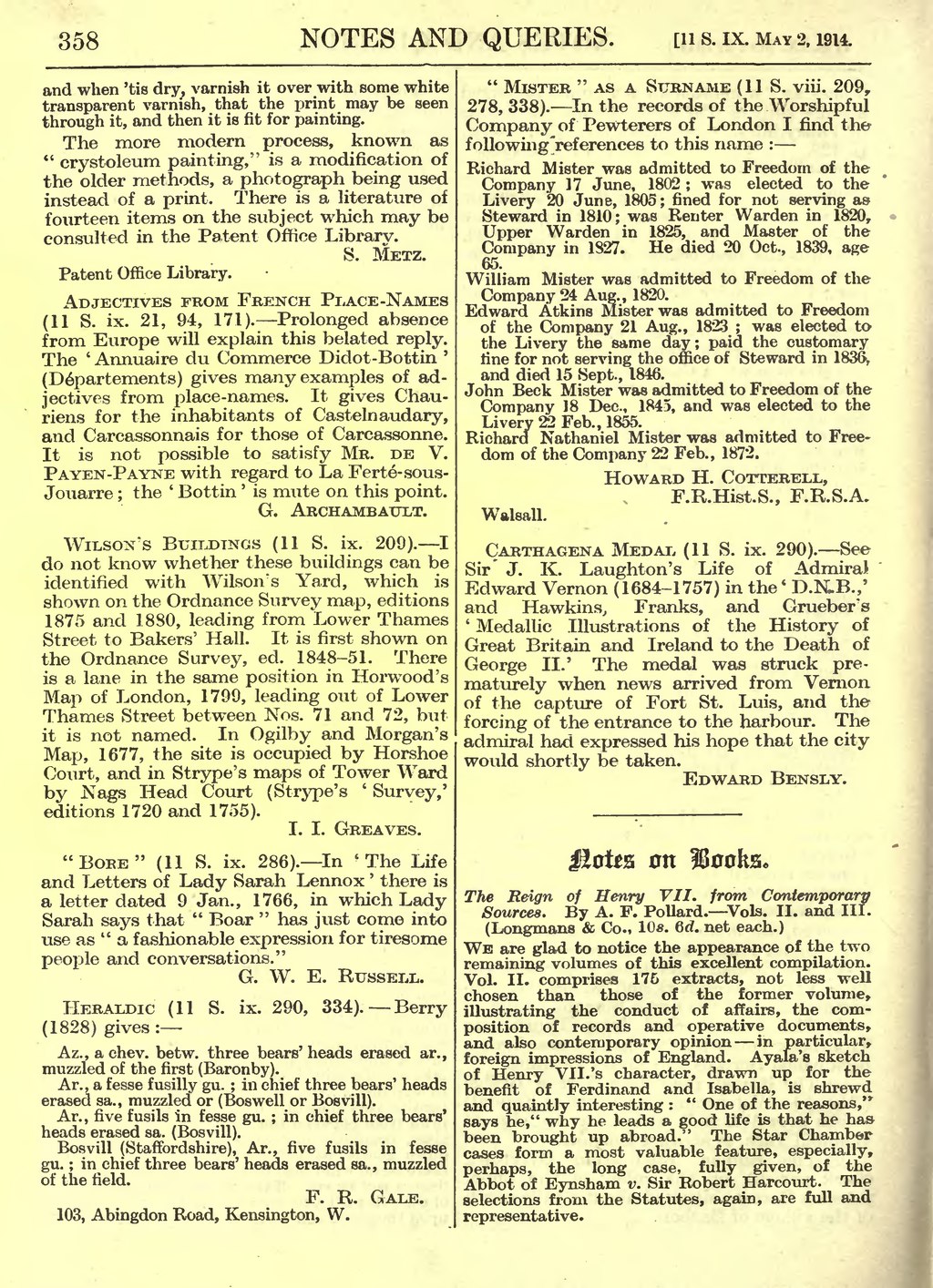358
NOTES AND QUERIES. [ii s. ix. MAY 2,
and when 'tis dry, varnish it over with some white
transparent varnish, that the print may be seen
through it, and then it is fit for painting.
The more modern process, known as " cryst oleum painting," is a modification of the older methods, a photograph being used instead of a print. There is a literature of fourteen items on the subject which may be consulted in the Patent Office Library.
S. METZ.
Patent Office Library.
ADJECTIVES FROM FRENCH PLACE-NAMES (11 S. ix. 21, 94, 171). Prolonged absence from Europe will explain this belated reply. The ' Annuaire du Commerce Didot-Bottin ' (Departements) gives many examples of ad- jectives from place-names. It gives Chau- riens for the inhabitants of Castelnaudary, and Carcassonnais for those of Carcassonne. It is not possible to satisfy MR. DE V. PA YEN -PAYNE with regard to La Ferte-sous- Jouarre ; the ' Bottin ' is mute on this point. G. ARCHAMBAULT.
WILSON'S BUILDINGS (11 S. ix. 209). I do not know whether these buildings can be identified with Wilson's Yard, which is shown on the Ordnance Survey map, editions 1875 and 1880, leading from Lower Thames Street to Bakers' Hall. It is first shown on the Ordnance Survey, ed. 1848-51. There is a lane in the same position in Horwood's Map of London, 1799, leading out of Lower Thames Street between Nos. 71 and 72, but it is not named. In Ogilby and Morgan's Map, 1677, the site is occupied by Horshoe Court, and in Strype's maps of Tower Ward by Nags Head Court (Strype's ' Survey,' editions 1720 and 1755).
I. I. GREAVES.
"BORE" (11 S. ix. 286). In 'The Life and Letters of Lady Sarah Lennox ' there is a letter dated 9 Jan., 1766, in which Lady Sarah says that " Boar " has just come into use as " a fashionable expression for tiresome people and conversations."
G. W. E. RUSSELL.
HERALDIC (11 S. ix. 290, 334). Berry (1828) gives :
Az., a chev. betw. three bears' heads erased ar., muzzled of the first (Baronby).
Ar. , a f esse f usilly gu. ; in chief three bears' heads erased sa., muzzled or (Boswell or Bosvill).
Ar., five fusils in fesse gu. ; in chief three bears' heads erased sa. (Bosvill).
Bosvill (Staffordshire), Ar., five fusils in fesse gu. ; in chief three bears' heads erased sa., muzzled of the field.
F. R. GALE.
103, Abingdon Road, Kensington, W.
" MISTER " AS A SURNAME (US. viii. 209,
278, 338). In the records of the Worshipful
Company of Pewterers of London I find the
folio win g'references to this name :
Richard Mister was admitted to Freedom of the Company 17 June, 1802 ; was elected to the Livery 20 June, 1805; fined for not serving as Steward in 1810; was Renter Warden in 1820, Upper Warden in 1825, and Master of the Company in 1827. He died 20 Oct., 1839, age 65.
William Mister was admitted to Freedom of the Company 24 Aug., 1820.
Edward Atkins Mister was admitted to Freedom of the Company 21 Aug., 1823 ; was elected to the Livery the same day ; paid the customary tine for not serving the office of Steward in 1836, and died 15 Sept., 1846.
John Beck Mister was admitted to Freedom of the Company 18 Dec., 1845, and was elected to the Li very 22 Feb., 1855.
Richard Nathaniel Mister was admitted to Free- dom of the Company 22 Feb., 1872.
HOWARD H. COTTERELL,
F.R.Hist.S., F.R.S.A,
Walsall.
CARTHAGENA MEDAL (11 S. ix. 290). See Sir J. K. Laughton's Life of Admiral Edward Vernon (1684-1757) in the * D.K.B.,' and Hawkins, Franks, and Cruebers ' Medallic Illustrations of the History of Great Britain and Ireland to the Death of George II.' The medal was struck pre- maturely when news arrived from Vemon of the capture of Fort St. Luis, and the forcing of the entrance to the harbour. The admiral had expressed his hope that the city would shortly be taken.
EDWARD BENSLY.
0tt
The Reign of Henry VII. from Contemporary Sources. By A. F. Pollard. Vols. II. and III. (Longmans & Co., 10s. Qd. net each.) WE are glad to notice the appearance of the two remaining volumes of this excellent compilation. Vol. II. comprises 175 extracts, not less well chosen than those of the former volume, illustrating the conduct of affairs, the com- position of records and operative documents, and also contemporary opinion in particular, foreign impressions of England. Ayala's sketch of Henry VII. 's character, drawn up for the benefit of Ferdinand and Isabella, is shrewd and quaintly interesting : " One of the reasons, " says ne," why he leads a good life is that he has been brought up abroad." The Star Chamber cases form a most valuable feature, especially, perhaps, the long case, fully given, of the Abbot of Eynsham v. Sir Robert Harcourt. The selections from the Statutes, again, are full and representative .
